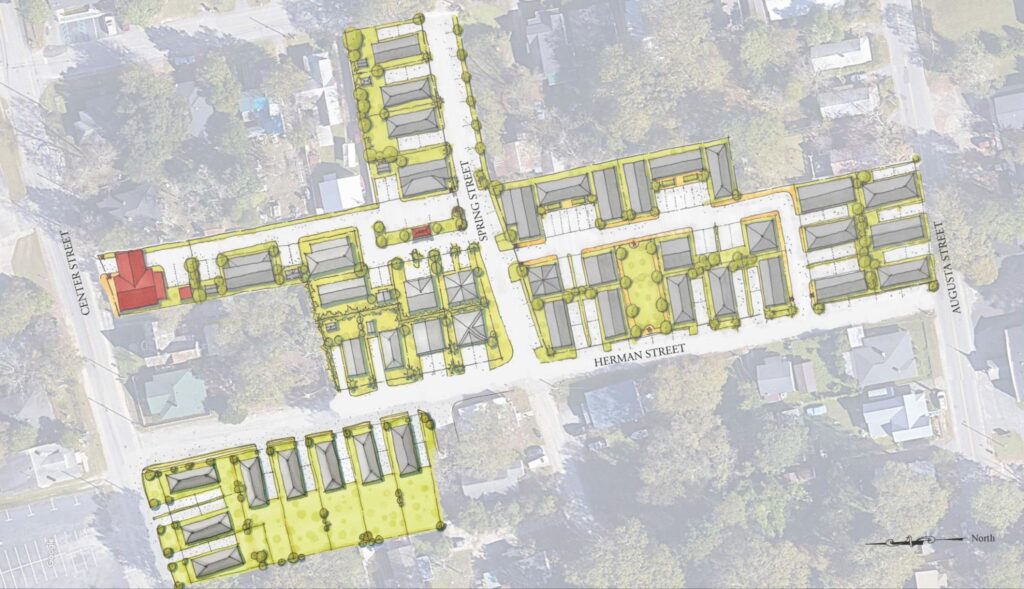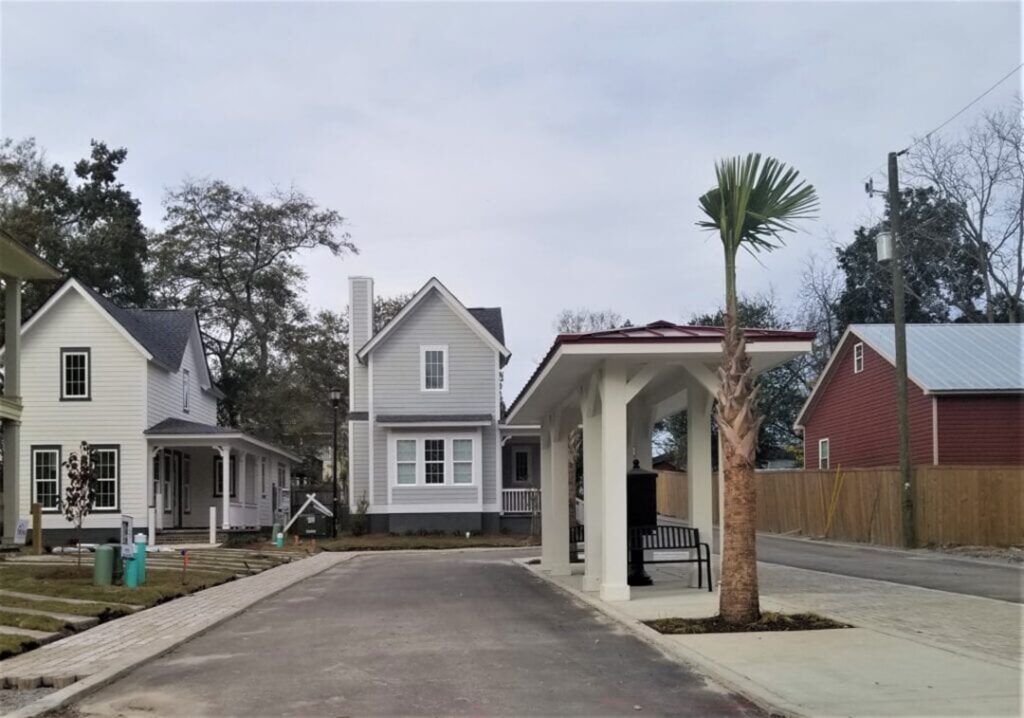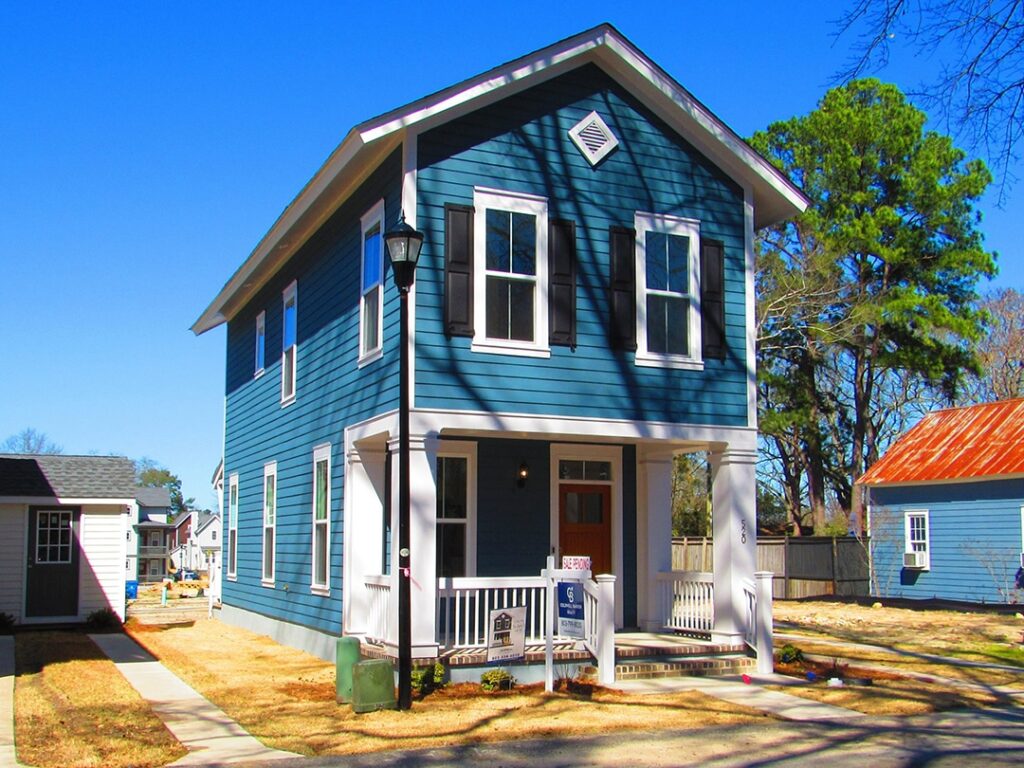
In 2022, a transformation took place. In the heart of West Columbia, SC, a patch of underused land was transformed into St. Ann’s Alley – a vibrant community of 34 homes, complete with a mixed-use building and a neighborhood park. This wasn’t just another construction project. It was a prime example of urban infill at its finest, and it has developers and city planners talking.
Cooter Ramsey, our co-founder and architect behind the project, didn’t just throw together some cookie-cutter houses. He and our team at Allison Ramsey Architects took a good, hard look at the neighborhood. “We wanted to fit in but also improve on what was already there,” Ramsey explained. We incorporated details, colors, and materials from the surrounding historic buildings, creating homes that felt like they’d always been part of the neighborhood.
St. Ann’s Alley wasn’t just about building houses. It was about bringing new life into an underused area, creating beautiful homes, and doing it all without paving over more green space on the outskirts of town.
In other words, it’s exactly what urban infill is all about.
What’s the Big Deal About Urban Infill?

Urban infill is all about making the most of the space we already have in our cities. Instead of spreading out and taking up more countryside, it’s looking at empty lots and old abandoned buildings and asking, “What if?”
And it’s not just a trend – it’s a smart way to grow our cities. Here’s why:
1. It’s Efficient
Urban infill takes advantage of land that already has the necessary infrastructure.
We’re talking about land that’s already hooked up to the grid – roads, power lines, water pipes, you name it. It’s all there, just waiting to be used.
Think about it: when developers build on the outskirts of town, they’re often starting from scratch. New roads need to be laid, power lines extended, and water and sewage systems installed. It’s time-consuming and expensive.
But with infill — half the work is already done.
This doesn’t just save small-scale builders money; it’s also easier on the city’s wallet. Less new infrastructure means lower maintenance costs down the line.
2. It’s Green
We’re recycling land that’s already been developed, giving it a second life.
Focusing on developing within an existing urban area helps curb urban sprawl, preserving more of our natural habitats that might otherwise be lost to new subdivisions.
But the green benefits don’t stop there. When people live in denser, more walkable neighborhoods, they drive less. That means fewer cars on the road, less traffic congestion, and a reduction in greenhouse gas emissions.
3. It Revitalizes Neighborhoods
A well-thought-out urban infill project can be the spark that brings a whole area back to life.
Picture a neighborhood with a few empty lots or abandoned buildings. It might be a bit rough around the edges, maybe even struggling. Now, place in a thoughtfully designed infill project, and suddenly, you have new residents, new energy, and new businesses to serve them.
Before you know it, a neglected area can transform into a vibrant, desirable neighborhood.
Why Small Developers Should Be Excited

If you’re a small developer or builder, urban infill projects like St. Ann’s Alley should definitely pique your interest. These projects offer a chance to make your mark on city landscapes without needing the deep pockets of big development firms.
Here’s why:
Lower Costs to Get Started: You’re not buying huge tracts of land or laying miles of new roads. That means you can often get started with less upfront cash.
High Demand: People are falling in love with city living again. They want to be close to work, shops, and fun – and they’re willing to pay for it.
Room for Creativity: Urban infill lets you flex your creative muscles. Got an old warehouse? Turn it into the coolest lofts in town. Dealing with a weird-shaped lot? Perfect. Show off your problem-solving skills with a unique design.
Community Impact: Here’s a feel-good bonus – your work can really make a difference. There’s something pretty special about walking down a street and seeing how your project has breathed new life into the area.
The Future Is Looking In, Not Out
As our cities continue to grow, urban infill isn’t just going to be a trend—it’s going to be a necessity.
Urban infill is where opportunity meets impact. For small developers ready to take on the challenge of working in established city areas, it’s a chance to create something unique, build an amazing portfolio, and be part of shaping the future of our cities.
Not a bad day’s work, right?
Whether you’ve got a vision for an empty lot downtown or you’re eyeing an old building with potential, Allison Ramsey Architects is ready to help you bring your urban infill dreams to life.

